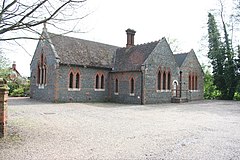Hoxne (pronounced 'Hoxen') is an ancient village in Suffolk, England, about five miles (8 km) east-southeast of Diss, Norfolk
| Hoxne | |
|---|---|
 Village Hall, Hoxne | |
| District | |
| Shire county | |
| Region | |
| Country | England |
| Sovereign state | United Kingdom |
| Post town | EYE |
| Postcode district | IP21 |

The area around the village is of great archaeological significance.
- It was one of the first places where flint hand axes were found (late 18th century).[1] John Frere [1740–1807], who lived at Roydon Hall in Diss, was the first person to recognise and write about the hand axes. He wrote a letter to the Society of Antiquaries. In this letter he connected the flints to strata in the site of an interglacial lake, part of the Hoxnian interglacial.
- It is the archaeological type site for the Hoxnian Stage or Hoxnian interglacial. The Hoxnian Stage is a middle Pleistocene stage of the geological history of the British Isles. It is equivalent to Marine Isotope Stage 11,[2][3][4][5] which started 424,000 years ago and ended 374,000 years ago.[6][7]
- It is the find-spot of the Hoxne Hoard of Roman treasure.
The village is also home to The Swan Inn. The Swan occupies a 15th Century, Grade II listed lodge, formerly known as Bishops Lodge. This pub is set at the bottom end of the village green, near Saint Edmund's memorial and bridge.[8] Built in 1480 by the Bishop of Norwich, The Swan has a long history; both the restaurant and bars reflect Hoxne's ecclesiastical past, with ornate ceiling beams and wide-planked floors.
References
Wikiwand in your browser!
Seamless Wikipedia browsing. On steroids.
Every time you click a link to Wikipedia, Wiktionary or Wikiquote in your browser's search results, it will show the modern Wikiwand interface.
Wikiwand extension is a five stars, simple, with minimum permission required to keep your browsing private, safe and transparent.
